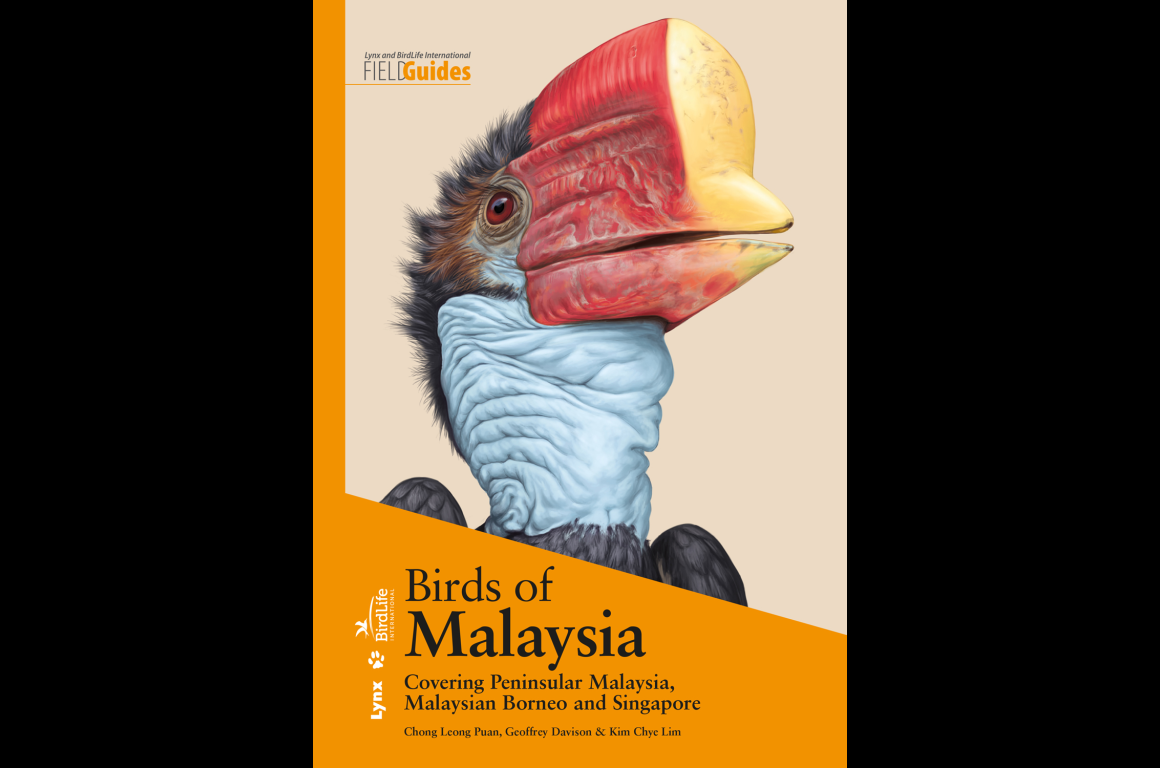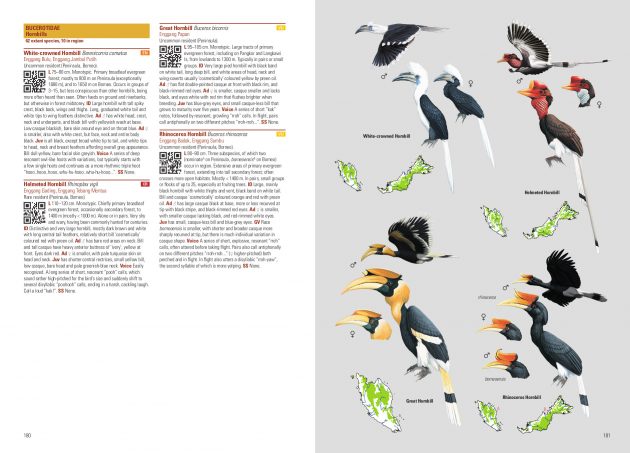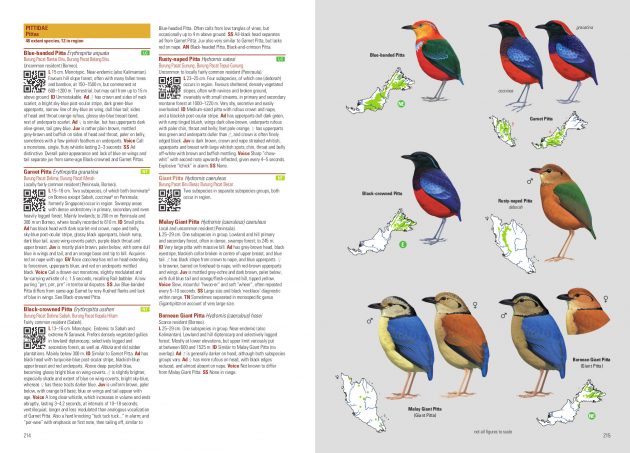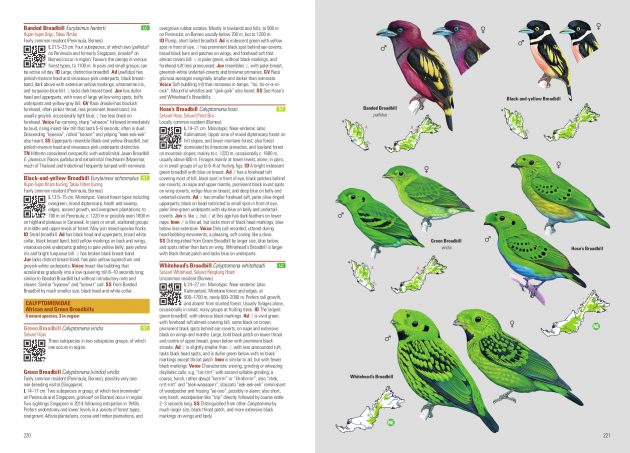
When you think of the best birding in the south of Asia, it is Malaysia that comes to mind, although you are likely not to even think of the country as such: you are dreaming of the (Malaysian) province of Sabah, in the north of the island of Borneo. Most of such bird tours are branded “Borneo”, without ever mentioning the name of the country in the name of the tour. There is a bit of further irony in it: the best birding in Asia is not even on the Asian mainland! However, amongst the 200 species birdable in 2 weeks, in Sabah you stand a chance of seeing more than 70 endemic and near-endemic birds, together with an array of pheasants, frogmouths, trogons, pittas, thrushes, and two of the most recently described birds in the world, Spectacled Flowerpecker and Cream-eyed Bulbul, both named to science only in 2019.
And the very best and the most up-to-date field guide is “Birds of Malaysia – Covering Peninsular Malaysia, Malaysian Borneo and Singapore”, the 2020 Lynx and BirdLife International Collection guide by Chong Leong Puan, Geoffrey Davison and Kim Chye Lim. The place for such bold claims is usually at the end of a review, but just as well, in case you are too lazy to read the entire text, I may start with it.
Malaysia comprises two halves separated by the South China Sea, the Peninsula and East Malaysia (northern Borneo), the latter made up of the states of Sabah and Sarawak. In addition, this new “Birds of Malaysia” guide also fully covers the independent Republic of Singapore, off the southern tip of the Malay Peninsula.

In 416 pages, 1800 illustrations and over 775 distribution maps covering regularly occurring species, “Birds of Malaysia” depicts all 847 species recorded in Malaysia and Singapore to date. Among them are 3 species endemic to Peninsular Malaysia, followed by 15 near-endemics (mostly birds of montane forest), and 5 are endemics of Malaysian Borneo, where further 67 species are near-endemics (both lowland and montane species). With some updates based on subsequent research, “Birds of Malaysia” taxonomically follows the “HBW and BirdLife International Illustrated Checklist of the Birds of the World”.
The format is 23 x 16 cm (9 x 6 in) and on my bird guide bookshelf it stands among the larger books, together with Robson’s “Birds of South-East Asia”. And yet, it easily fits the largest pocket of my reporter’s vest.
Inner covers hold a physical geography map of Malaysia in the front, and the same map in the back, this time with indexed 50 birding hotspots. The introduction covers the geography, climate, and especially important for the first-time visitor, the 9 habitat types. A brief overview of bird conservation in Malaysia follows, together with a list of threatened birds, also listing two data-deficient species, the White-faced Plover and the Blue-wattled Bulbul. The introductory chapters continue with another gem: on 7 pages, a not so brief overview of those 50 nature reserves and other hotspots, plus that hotspot map that is replicated here as well. In the back of the book there are two indexes, scientific and English names, and Malay bird names. The font size may be small, yet that is already the standard in field guides so I gave up complaining but started to wear glasses.
The bird ID text starts with the QR code for each species (linked to complementary audio-visual material), followed by the species name in English, scientific name and the Malay name (I especially respect the addition of the last one into the main text), its conservation and occurrence status, subspecies, size, habitat and behaviour, description (sexes, breeding vs. non-breeding plumages and age groups visibly separated by bold red lettering), voice, similar species and alternative names, sometimes followed with taxonomical notes (on, mostly, lumps, splits and possible splits). Well-marked subspecies groups receive full accounts, and the distributions of subspecies breeding in the region are clearly mapped.

The illustrations are already familiar, most of them being previously used in the “HBW and BirdLife International Illustrated Checklist of the Birds of the World”, although some new artwork is also included, depicting all the subspecies known from the country. There are 29 artists, but they all blend in seamlessly. As in the other Lynx field guides, apart from swallows and martins, no passerines are shown in flight, despite many of them showing striking wing patterns that immediately distinguish the species. Strangely, egrets are grey and not white. Also, there are no arrows to indicate the key identifying markings.
One of the unusual standards of Lynx & BLI field guides is the positioning of range maps. They aren’t at the text page, hence leaving more space for longer descriptions where necessary (which is not too often), but inside the plates, next to bird paintings, so you can quickly check whether the species occur in the particular region or not. It may not always be aesthetically pleasing (it depends on the shape of the country), but it does work well.
QR codes work great at home, but overseas you probably need a local SIM card to be able to use it without extra roaming charge (I wonder whether there is any phone signal in the rainforests of Borneo, but afterwards, your lodge should have Wi-Fi).

Every Lynx & BLI field guide is accompanied by the checklist card with a link and your personal code to download the .pdf checklist that follows the same taxonomy as your field guide (and you would not want it any other way). Besides the usual checkboxes to tick your sightings, it offers the additional info of the species status (from common to scarce, with geographical remarks such as “vagrant (Peninsula)”).
After completing his PhD in Wildlife Ecology from the University of Queensland, Australia, the first author, Chong Leong Puan, continues his research on Malaysian birds. He is currently an Associate Professor at the Faculty of Forestry and Environment, University Putra Malaysia.
Geoffrey Davison obtained his PhD from the University of Malaya. He subsequently lectured at the National University of Malaysia, with research on the effects of large infrastructure projects on tropical birds and mammals. More recently he has been a staff member of the National Parks Board, Singapore.
Kim Chye took early retirement to pursue his interest in birds, and served with the Malaysian Nature Society as its Ornithological Officer, focusing on hornbill conservation and raptor migration projects.
In conclusion, whether you are planning a comprehensive birding tour of both Peninsula and Sabah, or a quick tour of Mount Kinabalu, Lower Kinabatangan River and the Danum Valley, look no further: “Birds of Malaysia – Covering Peninsular Malaysia, Malaysian Borneo and Singapore” is the book of choice. The artwork is captivating, the text is authoritative and easy to follow, and the layout and design are unsurpassed – I can’t recommend this book highly enough.
Birds of Malaysia: Covering Peninsular Malaysia, Malaysian Borneo and Singapore
Lynx and BirdLife International field guides
Authors Chong Leong Puan, G. W. H. Davison, Chye Lim Kim, with Alex Berryman, Chris Bradshaw, Tim Marlow
Illustrated by Richard Allen, Norman Arlott, Hilary Burn, Clive Byers, John Cox, François Desbordes, Martin Elliott, Alan Harris, Ren Hathway, Mark Hulme, Àngels Jutglar, Francesc Jutglar, Ian Lewington, Toni Llobet, Alex Mascarell, Dave Nurney, Douglas Pratt, David Quinn, Chris Rose, Lluís Sanz, Brian Small, Lluís Solé, Juan Varela, Velikov Ilian, Etel Vilaró, Jan Wilczur, Ian Willis, Martin Woodcock, Tim Worfolk
Publisher Lynx Edicions, 2020
ISBN 978-84-16728-30-5 Flexi-cover, 978-84-16728-29-9 Hardback
Length 416 pages













For reasons unknown, this publication has been discontinued.